Table of contents
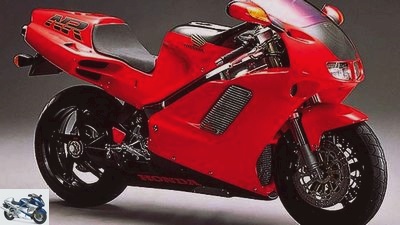
Honda
counselor
technology & future
Honda NR 750 with oval piston engine
Motorcycle story
Honda NR 750 with oval piston engine
In 1991, Honda presented a visionary motorcycle with the NR 750. The project caused a sensation with highly developed technical details and a sensation with its oval piston engine. MOTORRAD employee Alan Cathcart was there at the time – and was allowed to drive the NR again 20 years later.
Michael Pfeiffer
02/15/2012
The Honda mumbles cautiously from its two mufflers, even responding to courageous throttles with discreet acoustic restraint. In a flash, the pale memories take on color again, suddenly making this day 20 years ago as present as yesterday. October 1991, Circuit Le Castellet. Honda presents the NR 750. Hardly any other motorcycle generated more curiosity than this unorthodox concept. The Honda engineers applied for more than 200 patents during the development of this technology carrier. It is understandable that with so much substance there was no need for screaming ingratiation. And certainly no exhaust roar.
Buy complete article
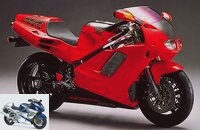
Motorcycle story
Honda NR 750 with oval piston engine
6 pages) as PDF
€ 2.00
Buy now
Even two decades later, the NR 750 is still surrounded by an aura of something very special. She was a child of her time. Like the steering knuckle-steered Yamaha GTS 1000 (1993) or the Norton TT (1992) driven by a Wankel engine in search of new paths. But this NR was ahead of its time. Petrol injection, cassette gears, titanium connecting rods, anti-hopping clutch, carbon fiber cladding, digital speedometer – the NR 750 was bursting with technical solutions that would only gradually establish themselves in the course of the next decade. But all that faded behind the crowning glory of this ensemble, the oval piston engine.
The logic behind this design makes sense: Compared to a conventional two-cylinder of the same displacement, an oval cylinder head offers more space for larger valves and a correspondingly better filling. Since the stroke is extremely short in relation to the large bore, the oscillating masses are around ten percent lower compared to the two-cylinder, and the internal friction is also reduced, this construction principle also promises the high level of turning pleasure required for high peak performance. The only problem area: the sealing of the combustion chamber. Only the slightly curved shape of the long side of the piston (super ellipse) enabled sufficient contact pressure of the piston rings.
The Honda technicians had already committed themselves years before the goal of bringing this design principle to series production. As early as March 1978, an oval piston purred in the cylinder of a single-cylinder XL 250 engine for the very first time. Four months later, the design forerunner of the NR 750 engine barked on the test bench. A 100-degree V4 engine with a displacement of 500 cm³, two connecting rods per piston as well as eight valves and two spark plugs per combustion chamber. Maximum speed: 20,000 / min.
As obvious as the advantages of the oval piston principle may be in theory, this technology had a hard time on the most relentless of all test benches, in racing. After four years of unequal and unsuccessful struggle (best placement: eleventh place at the GP in Spa) against the half-liter two-stroke cars, the factory involvement with the NR 500 was discontinued in 1982.
Ultimately, the NR concept owed its survival only to a final show of strength in the 1987 season. It was only when the NR engine, enlarged to 750 cc, was allowed to compete with conventional four-stroke engines of the same displacement at the 24 Hours of Le Mans and the Australian Swann Series, the idea rehabilitated. But the podium placements came too late. The oval piston engine had had its day on the racetrack.
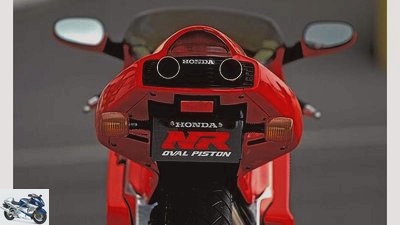
Cathcart
Inspiration: Even star designer Massimo Tamburini was inspired by the underseat exhaust system of the NR 750 for the style icon Ducati 916 presented two years after the NR. Technological miracle: oval pistons, eight valves per cylinder – and over a decade of development time.
Perhaps it is also due to this broken relationship to racing that the NR 750 already looks very civil at the first seat test, in contrast to its sister model at the time, the thoroughly sporty RC 30. With relatively high handlebars, deep footrests and a comfortable seat, it is more touristy and comfortable than sporty. And as then, there is now a bit of disillusionment. Handling is not the avant-garde’s thing. The machine, which weighs 244 kilograms with a full tank, can only be turned in slowly. Is it because of the weight or the uncomfortable combination of a 130 millimeter wide front tire with a 16 inch rim? After all, the Honda follows the chosen line calmly and stoically, with its comfortably tuned massive upside-down fork (45 millimeter dip tubes) and the suspension strut hinged via the Pro-Link lever, sniffs out every little bump, even in an inclined position. But restraint is still the order of the day. Krrrrrk – the footpegs scrape across the asphalt even on a civil incline. Gas off, immediately. Because even at that presentation, the NR cladding touched the asphalt shortly after this first warning sound.
And today nobody would want to pay the bill for a new lower part of this rare carbon casing. Falling is of course on the index. At that time, Honda demanded a proud 100,000 marks for the spearhead of technology. Delivery against prepayment and without a test drive. The auction of the very first NR 750 produced brought in as much as 140,000 marks. The obviously solvent buyer: Jan Smit, a Dutch Ducati importer.
Only the engine responds to the feelings that admirers of its technology have for it. The propellant pushes forwards, almost vibration-free, and twists its way through the speed ladder in a flash. 10,000, 12,000, 15,000 revolutions – the 90-degree V4 clicks into the rev limiter with impressive ease. As if he wanted to prove at every moment how efficiently the oval piston concept translates the mathematical advantage of reduced internal friction into practice. This lightness relativizes the fact that the 125 HP peak power (RC 30: 122 HP) is only available at 14,000 rpm. What manners, what finesse. You hardly dare to grasp the throttle grip roughly with your whole hand; you prefer to use your thumb and a pointed index finger to control the throttle. The enormous development work, the years of fine-tuning, the dedication of the engineers, all of this manifests itself in this mechanism. The components are perfectly coordinated and the tolerances are reduced to a minimum. You can feel how smoothly the fresh gas from the injection system – the first on a Japanese super sports car, by the way – flows through the gaps in the four inlet valves of each cylinder, which are opened by camshafts precisely driven by gear cascades. You can feel how cleanly the mixture, compressed by the 101.2 millimeter wide pistons and ignited by two spark plugs, burns.
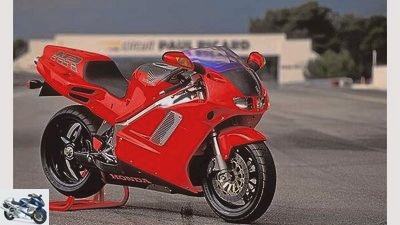
Cathcart
Noblesse oblige: Even after 20 years, the NR 750 impresses with its harmonious appearance. With elements such as the indicators integrated into the mirrors, the NR was ahead of its time. The massive upside-down fork with 45 mm dip tubes was also a novelty in Japanese sports motorcycle construction. The workmanship was of the highest quality.
It was only logical that the power generated in this way via a cassette gearbox common in racing and an anti-hopping clutch that also worked excellently by today’s standards, still technically referred to as a clutch with back torque limiter at the time, made its way to the 180 mm rear tire.
But all this technical fine-tuning, all this courage to consistently innovate, should not be economically rewarded. Perhaps the exorbitant price excluded too many interested parties, perhaps the lack of sporty orientation of the NR 750 was disappointing. The fact was: In the end, only 300 buyers were found worldwide for the 1000 machines originally planned, 15 of them in Germany. After the production of the second batch in 1992, Honda closed the chapter on oval piston engines in the company’s history.
Info
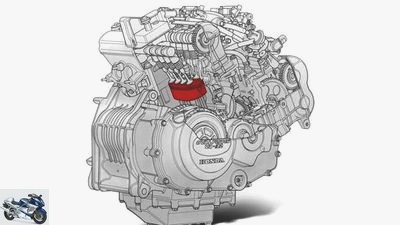
Cathcart
Siding instead of a successful track: Whether it was due to the not very sporty orientation, the exorbitant price (100,000 euros) or the unorthodox oval piston technology – the NR 750 was only bought by 300 buyers.
engine:
90-degree V4 four-stroke engine, oval piston 101.2 x 50.6 mm, stroke 42 mm, displacement 747.6 cm³, two titanium connecting rods each, eight valves per cylinder (20 and 18 mm diameter), programmable injection / ignition, anti -Hopping clutch, six-speed cassette transmission; Rated output: 92 kW (125 hp) at 14,000 rpm; Max. Torque: 71 Nm (7.0 kpm) at 11500 rpm.
landing gear:
Aluminum bridge frame, 45 mm upside-down fork at the front, single-sided swing arm at the rear, double disc brake at the front, Ø 310 mm, single-disc brake at the rear, Ø 220 mm, tires 130/70 ZR 16 and 180/55 ZR 17.
Measurements and weight:
Wheelbase 1433 mm, caster 88 mm, weight with a full tank 244 kg, tank capacity 17.3 liters, top speed 263 km / h. Price 100,000 marks (1991).
Related articles
-
fact motorcycles 20 years of Honda VFR 20 years of Honda VFR Formula V The powerful, growling V4 engine, the soul of every VFR, has kept the Honda fan…
-
Technology: engine technology super sports car
fact 23 pictures fact 1/23 The Honda Fireblade has been a great performer for twenty years. PS takes a close look at the development of engine…
-
Honda CMX 1100 Rebel: Large cruiser with Africa Twin engine
News 2022 New motorcycle items for 2022 Honda 17th pictures Honda 1/17 The rumors of a great rebel have been around for a long time, now it’s here. Honda…
-
Bilski motorcycles Naked bike Top test Honda Hornet 600 Top test Honda Hornet 600 Salute Europe’s top seller 2002. Unfortunately only 25th in Germany. So…
-
Honda NT 1100: Crossover bike with Africa Twin engine
Honda 18th pictures Honda 1/18 Honda has patented new frame concepts for the two-cylinder Africa Twin. Honda 2/18 The patent lists two framework…
-
Honda CL 350 custom bike: two-stroke engine with 100 hp
Jason Stillgebouer 11 pictures Jason Stillgebouer 1/11 Drew screwed the frame of a Honda CL 350, a two-stroke from Yamaha. Jason Stillgebouer 2/11 The…
-
Honda CB 500 in the 50,000 kilometer test
archive motorcycles Honda CB 500 in the 50,000 kilometer test Honda CB 500 in 50,000 kilometer test (1996) Classic bread-and-butter motorcycle So small,…
-
Honda CBR 300 R and Honda CBR 500 R in comparison test
Gargolov 33 pictures Rossen Gargolov 1/33 Two against one is not fair? We see how the single-cylinder Honda CBR 300 R fares against the two-cylinder…
-
Screwdriver tip exhaust system – Honda CB 750 Seven Fifty
Ralf Petersen 14th pictures Ralf Petersen 1/14 The starting point: a Honda CB 750 Sevenfifty for 850 euros, first registration February 1994. Ralf…
-
Tadao Baba – The father of the Honda Fireblade
Honda Sports & scene Tadao Baba – The father of the Honda Fireblade Portrait: Tadao Baba The father of the Honda Fireblade When Honda launched the…